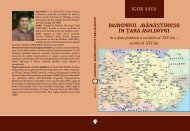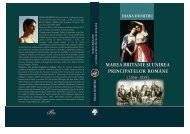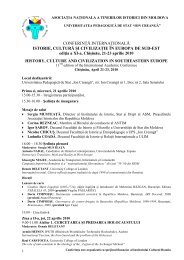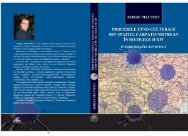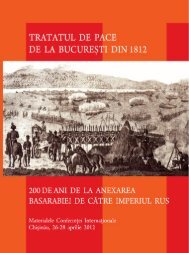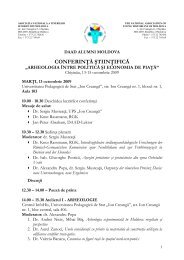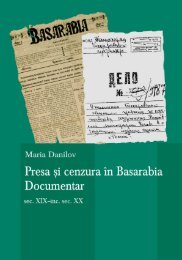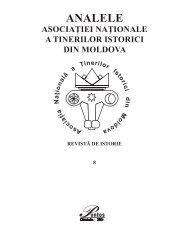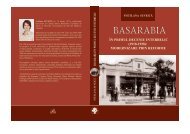LUCIA SAVA, Viaţa cotidiană în oraşul Chişinău la - Asociatia ...
LUCIA SAVA, Viaţa cotidiană în oraşul Chişinău la - Asociatia ...
LUCIA SAVA, Viaţa cotidiană în oraşul Chişinău la - Asociatia ...
Create successful ePaper yourself
Turn your PDF publications into a flip-book with our unique Google optimized e-Paper software.
<strong>Viaţa</strong> <strong>cotidiană</strong> <strong>în</strong> <strong>oraşul</strong> <strong>Chişinău</strong> <strong>la</strong> <strong>în</strong>ceputul secoului al XX-lea (1900-1918)<br />
221<br />
well as providing food. Forests occupy the whole county Chisinau reaching<br />
Orhei and were p<strong>la</strong>ced on the chain of mountains Mehur.<br />
1.1.2. The Urban areas<br />
The advantage to be a capital. The creation of Tsarist era (St. Ciobanu),<br />
in terms of form and outside the city fully justifies the findings of A. Toynbee<br />
regarding how to choose the capital on the grounds of convenience: both in<br />
terms of conditions supply goods in connection with the provincial administration<br />
and in maintaining security but also on considerations in selecting<br />
capital strategy. Evolution as the capital was determined <strong>la</strong>rgely by the fact<br />
that Chisinau was formed in a context of economic and social, political, ideological<br />
and cultural specific environment due to Russian influence, issues that<br />
have left imprints on evolution of mentalities and everyday life.<br />
Streets and neighborhoods. Like most cities of the Russian Empire,<br />
Chisinau occupy a <strong>la</strong>rge territory, and the buildings were separated by streets,<br />
grouped in neighborhoods. In the early twentieth century Chisinau occupy<br />
an area of approximately 4 500 desetine of <strong>la</strong>nd, of which 770 were reserved<br />
for houses and yards, and 2 500 were occupied by gardens and vineyards. City<br />
area in 1900 increased further by 2 088 desetine by peripheral Visterniceni<br />
estate purchase, which will be built Rascani urban area. In the period studied,<br />
the city was divided conventionally into four sectors, according to the p<strong>la</strong>n<br />
drawn up by architect Zauşkevici, Chisinau was divided in 102 streets, 20<br />
streets, 269 districts, which included 12 churches, 35 public buildings and<br />
state institutions, 11 markets 10 barriers, seven bridges and five suburbs.<br />
To the Union of Bessarabia with Romania were not recorded substantial<br />
changes in dividing the city, except change the names of streets, occurred in<br />
1912. After the Great Union, much of the streets have been renamed, so that<br />
in the interwar period they were 2-3 names.<br />
1.1.3. Popu<strong>la</strong>tion<br />
A wen. The popu<strong>la</strong>tion and the demografic situation was a current<br />
problem for the early twentieth century, it was provided that the Chisinau<br />
city with most inhabitants of the province of Bessarabia and one of the most<br />
popu<strong>la</strong>ted cities of the Russian Empire.<br />
Like other capital, Chisinau p<strong>la</strong>yed the crucible, attracting immigrants from<br />
different p<strong>la</strong>ces with different mother tongues, different habits and manners<br />
and in different social c<strong>la</strong>sses. This one was apparently normal in terms of<br />
Russification and the denationalization policy pursued by the Tsarist authori-



